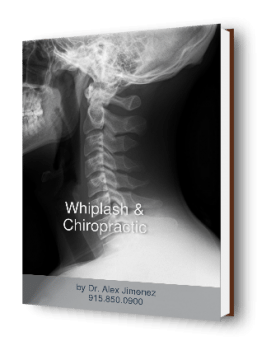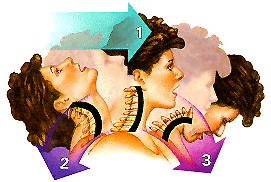For those who’ve been involved in car accidents, whiplash type injuries should be a very serious concern. Often times, the symptoms associated with a whiplash injury can develop several weeks or even months after the incident and it can be easy for an individual to believe there were no injuries as a result of the auto collision. Because of this, a majority of people don’t seek medical treatment following the wide variety of car accidents. Whiplash-associated injuries are among the most common neck injuries. Whiplash is caused by an abrupt movement of the head, either backward, forward, or sideways, which damages the supporting muscles, ligaments and other connective tissues in the neck and upper back.

Unfortunately, when further complications begin to signal the underlying presence of an injury, the damage from the injury may have become permanent. An abundance of studies has demonstrated that approximately half of all car accidents with people who suffered whiplash that settled their insurance claims, may still suffer with symptoms from their injuries. If you’ve been involved in a single type of the various car accidents, don’t jump into conclusions and assume that you’ve evaded injury simply because you’re currently not in any pain.

The term whiplash was initially utilized in 1928 to identify an injury mechanism of sudden hyperextension followed by an immediate hyperflexion of the neck, resulting in damaged muscles, tendons and ligaments, most specifically, those supporting the head. Presently, we understand that this type of injury doesn’t necessarily occur as a result of extension and flexion beyond its natural range, instead, whiplash injuries are known to occur from an extremely rapid extension and flexion of the neck in any direction.
Because of their misunderstood, complex nature and the serious impact these could have on people’s lifestyles, only a limited amount of topics in the healthcare field have created as much controversy as whiplash injuries caused by car accidents. Differentiating from a fractured bone where a simple X-ray can confirm its presence and health care guidelines can address a medical professional as to the best way in which to manage the injury, whiplash injuries could affect an unpredictable combination of nerves, muscle joints and connective tissue which is often difficult to diagnose and can be even more challenging to treat. In order to help the individual better comprehend the nature of whiplash-associated injuries and how these should be properly treated, it is necessary to invest some time discussing the mechanics of how whiplash injuries occur.

Table of Contents
The Phases of a Whiplash Injury
During the majority of rear-end car accidents, the body undergoes through an excessively rapid and forceful acceleration and deceleration. As a matter of fact, all four phases of a whiplash injury occur in less than one-half of a second. With each phase, a different force affects the body, contributing to the overall injury, and with such an abrupt and intense movement, damage to the vertebrae, nerves, discs, muscles, tendons and ligaments within the neck and cervical spine can be substantial.
Phase 1
At the first phase of whiplash, the car starts to be pushed out from under the involved individual, causing the mid-back to be flattened against the back of the sear. This results in an upward force in the cervical spine, compressing the discs and joints. The back of the seat then follows by accelerating the torso forward, causing the head to move backwards, creating a powerful force against the neck. If your head restraint is properly adjusted, the distance the head moves backwards at this point is decreased. However, the majority of the damage to the spine will have already occurred before the head reaches the head restraint. Several studies indicate that head restraints merely reduce the risk of injury by 11 to 20 percent.
Phase 2
By phase two, the individual’s torso will have reached peak acceleration, up to 1.5 or 2 times that of the vehicle itself, but at this point, the head has not yet begun to accelerate forward and it still continues to move backwards. An abnormal S-shaped curvature develops in the cervical spine as the car seat rebounds forward, similar to a springboard, increasing the forward acceleration of the torso. This forward seat recoil unfortunately occurs while the head is still moving backwards, and the shearing force which is placed in the neck during this phase is one of the most damaging aspects of a whiplash injury. Many bone, joint, nerve, disc and even TMJ injuries occur during phase 2.
Phase 3
During phase three, the torso now begins to settle back down into the seat while the head and neck are at their peak forward acceleration. Simultaneously, the car begins slowing down. If the individual released the pressure on the brake pedal during the first and second phases of the collision, it will most likely be re-applied during this phase. By re-applying the brake, the individual causes the vehicle to slow down more rapidly, increasing the severity of the flexion injury in the neck. As the involved victim moves forward into their seat, the loose seat belt and shoulder harness is used up.
Phase 4
Phase four is believed to be the most damaging phase of whiplash. In this phase, the torso is stopped by the seat belt and shoulder restraint while the head can freely move forward, unimpeded. This leads to a powerful and violent, forward-bending motion of the neck which strains the muscles and ligaments, tearing fibers in the spinal discs and forcing vertebrae out of their natural placements. The spinal cord and nerve roots are stretched, becoming irritated while the brain can often collide against the inside of the skull, resulting in mild to moderate brain injury. If you are not properly restrained by your seat belt, a concussion or more severe brain injury can occur from striking the steering wheel or windshield of the car.

Types of Injuries Caused by Whiplash
As previously mentioned, whiplash injuries can develop into a variety of symptoms, including neck pain, headaches, fatigue, upper back, shoulder and low back pain and may cause cognitive alterations. Due to the fact that numerous factors can play a huge part into the overall trauma from whiplash, such as the direction of the impact, the speed of the cars involved as well as sex, age and physical condition, it is considered impossible to predict the pattern of symptoms that each individual will experience. In addition, the symptoms of whiplash are frequently delayed, taking up to weeks or months to develop on the individual. There are, however, a variety of injuries and conditions that are very common among those who have suffered from whiplash trauma.
Neck Pain
Neck pain is the single, most common complaint among individuals with whiplash, reported by over 90 percent of patients. The pain frequently radiates across the shoulders, into the head and down between the shoulder blades. The trauma from whiplash tends to damage a majority of the tissues found within the neck, including the facet joints and discs between the vertebrae as well as all of the surrounding muscles, ligaments and nerves.
Facet joint pain is the most frequent reason for neck pain following many car accidents. This type of pain is generally experienced on the back of the neck, usually to the right of left of the center, and is commonly tender to the touch. Facet joint pain cannot be diagnosed using X-rays or MRIs. It can only be diagnosed by physical palpation of the area.
Disc injury is also a frequent cause for neck pain, particularly chronic pain. The annulus, or outer wall of a vertebral disc, consists of bundles of fibers which can be torn during whiplash injuries. These tears can then lead to disc degeneration or herniation, causing irritation and/or compression on the nerves running through the region. This compression or irritation commonly leads to radiating pain down the arms, shoulders and upper back, leading to muscle weakness.
The damage or injury to the muscles and ligaments within the neck and upper back are the dominant cause of the pain experienced during the first few weeks after an individual has suffered a whiplash injury and it’s the main cause why the involved victims experience stiffness and limited range of motion. Although, as the muscles begin to heal, they normally don’t cause as much pain as they contribute to abnormal movement. Damage or injury to the ligaments commonly causes irregular mobility and instability.
Headaches
Additionally, from experiencing neck pain, headaches are the most widespread issue among those individuals suffering from whiplash injury, affecting more than 80 percent of all people. While some headaches are the actual result of direct brain injury, most are related to injury of the muscles, ligaments and facet joints of the cervical spine, which cause pain to the head. Due to this, it’s essential to treat the supporting tissues of the neck in order to help decrease or eliminate the individual’s headaches.
TMJ Complications
A less frequent but almost equally as impairing disorder which results from whiplash is temporomandibular joint dysfunction, best known as TMJ. Temporomandibular joint dysfunction generally manifests as pain, clicking and popping noises in the jaw during movement. If TMJ complications are not properly evaluated and cared for, the issues may worsen further and lead to headaches, facial and ear pain, and difficulty eating. Many doctors of chiropractic specialize in treating TMJ issues or can refer the affected individual to a TMJ specialist.
Brain Injury
Mild to moderate brain injuries are fairly common after a whiplash injury, mainly because of the forces from the impact during the four phases mentioned above. The human brain is a soft structure, suspended in a watery fluid called cerebrospinal fluid. When the brain goes through the extreme forward and backward motion, the brain bounces off the inside of the skull, causing bruising or bleeding in the brain itself. In several cases, the individual can lose consciousness and have symptoms of a mild concussion. More often than not, there is no loss of consciousness, however, individuals report feeling minor confusion or disorientation immediately after these type of car accidents. The long-term complications of a mild brain injury can include, mild confusion, concentration problems, sleep disturbances, irritability, memory issues, loss of sex drive, depression and emotional instability. Despite being less common, the nerves that function to provide your sense of smell, taste and your vision may be affected as well, leading to a muted sense of taste, changes in the sensation of smell and visual disturbances.
Dizziness
After a whiplash injury, dizziness usually results from injury to the facet joints of the cervical spine, however, in various cases, injury to the brain or brain stem may be a contributing factor as well. Typically, dizziness from whiplash is only temporary, improving considerably after chiropractic treatment.
Low Back Pain
Albeit a majority of people recognize whiplash as an injury of the neck, injury to the low back may also occur. As a matter of fact, low back pain can be found in more than half of rear impact collisions in which injury was reported and in almost three-quarters of all side impact crashes. This is mostly due to the fact that the low back also suffers tremendous compression during the first two phases of a whiplash type injury, regardless if it does not have the degree of flexion-extension damage experienced in the neck.
Whiplash Recovery from Car Accidents
With appropriate care from specialized healthcare providers in car accidents and injuries, a majority of mild whiplash injuries heal within six to nine months. However, more than 20 percent of individuals who’ve experienced whiplash may continue to suffer from pain, weakness or limited mobility for up to two years after the initial car accidents. The wide majority of these people will unfortunately continue to experience some degree of impairment or pain for many years after that, if not for the rest of their lives.
Whiplash is a unique and challenging condition, that’s why it requires the expertise of a skilled health professional specially trained to work with these types of injuries. The most effective treatment for whiplash-associated injuries involves a combination of chiropractic care, rehabilitation of the soft tissues and self-care at home.
Chiropractic Care
Through the use of spinal adjustments and manual manipulations of the spine, chiropractic treatment focuses on restoring the normal movement and position of the spinal vertebrae. According to research, chiropractic is by far the single-most effective treatment for eliminating the long-term impact of whiplash injuries, especially when combined with massage therapy, trigger point therapy, exercise rehabilitation and other soft tissue rehabilitation techniques.
Soft Tissue Rehabilitation
The term soft tissue is utilized to refer to a specific tissue that is not bone, such as muscles, tendons, ligaments, nervous system, spinal discs and internal organs. When whiplash occurs, the tissues that are affected the most are the soft tissues, particularly the muscles, ligaments and discs. In order to minimize permanent disability and impairment, it’s essential to utilize treatments and therapies that focus on stimulating the soft tissues to heal properly. These include massage therapy, electro-stimulation, trigger point therapy, stretching and specific strength and range of motion exercises.
Self-Care
Even the most effective chiropractic care and soft tissue rehabilitation may be restricted in its benefits if your home or work activities stress or re-injures the individual on a regular basis. Because of this, it’s crucial to prepare a detailed, extensive plan of care between the hours and days of your clinic visits to help speed up the recovery process. Some of the most common home self-care therapies include the use of ice therapy, limitations on daily or work activities, an appropriate set of stretches and exercises, taking nutritional supplements and getting plenty of rest.
Medical Intervention
With more severe cases of whiplash, it may be necessary for the individual to receive some medical care as part of their overall treatment plan. The most common medical intervention treatments include the use of anti-inflammatory medications, muscle relaxants, trigger point injections and, in some cases, epidural spinal injections. Drugs should be used for short-term relief of pain as the medications can only temporarily decrease the symptoms and cannot restore normal joint movement or stimulate healthy muscle repair. Fortunately, surgery is only required in more severe cases of whiplash where herniated discs develop, when a disc is pressing on the spinal cord, and during several cases of spinal fractures. Your healthcare provider should be able to determine if medical care is needed alongside chiropractic treatment.
Documenting an Injury 
It’s extremely important to document the progress of an injury with a chiropractic physician. The whiplash injury sustained by the individual from rear-end car accidents may be permanent or may have left residual symptoms after treatment is completed. Once an insurance company has settled a case, health care is no longer covered. You may need care in the future and this needs to be documented. It’s essential to seek the help of a doctor with plenty of experience and someone who understands the mechanisms of injury and their long-term effect.
Whiplash injuries are often misunderstood and, although the pain and discomfort of this type of injury may not always develop immediately, it’s essential for the individual to seek proper care from a chiropractor who specializes in soft tissue injuries. For more information, please feel free to ask Dr. Jimenez or contact us at 915-850-0900 .
Sourced through Scoop.it from: www.elpasochiropractorblog.com
By Dr. Alex Jimenez
Post Disclaimer
Professional Scope of Practice *
The information on this blog site is not intended to replace a one-on-one relationship with a qualified healthcare professional or licensed physician and is not medical advice. We encourage you to make healthcare decisions based on your research and partnership with a qualified healthcare professional.
Blog Information & Scope Discussions
Welcome to El Paso's Premier Wellness and Injury Care Clinic & Wellness Blog, where Dr. Alex Jimenez, DC, FNP-C, a board-certified Family Practice Nurse Practitioner (FNP-BC) and Chiropractor (DC), presents insights on how our team is dedicated to holistic healing and personalized care. Our practice aligns with evidence-based treatment protocols inspired by integrative medicine principles, similar to those found on this site and our family practice-based chiromed.com site, focusing on restoring health naturally for patients of all ages.
Our areas of chiropractic practice include Wellness & Nutrition, Chronic Pain, Personal Injury, Auto Accident Care, Work Injuries, Back Injury, Low Back Pain, Neck Pain, Migraine Headaches, Sports Injuries, Severe Sciatica, Scoliosis, Complex Herniated Discs, Fibromyalgia, Chronic Pain, Complex Injuries, Stress Management, Functional Medicine Treatments, and in-scope care protocols.
Our information scope is limited to chiropractic, musculoskeletal, physical medicine, wellness, contributing etiological viscerosomatic disturbances within clinical presentations, associated somato-visceral reflex clinical dynamics, subluxation complexes, sensitive health issues, and functional medicine articles, topics, and discussions.
We provide and present clinical collaboration with specialists from various disciplines. Each specialist is governed by their professional scope of practice and their jurisdiction of licensure. We use functional health & wellness protocols to treat and support care for the injuries or disorders of the musculoskeletal system.
Our videos, posts, topics, subjects, and insights cover clinical matters and issues that relate to and directly or indirectly support our clinical scope of practice.*
Our office has made a reasonable effort to provide supportive citations and has identified relevant research studies that support our posts. We provide copies of supporting research studies available to regulatory boards and the public upon request.
We understand that we cover matters that require an additional explanation of how they may assist in a particular care plan or treatment protocol; therefore, to discuss the subject matter above further, please feel free to ask Dr. Alex Jimenez, DC, APRN, FNP-BC, or contact us at 915-850-0900.
We are here to help you and your family.
Blessings
Dr. Alex Jimenez DC, MSACP, APRN, FNP-BC*, CCST, IFMCP, CFMP, ATN
email: coach@elpasofunctionalmedicine.com
Licensed as a Doctor of Chiropractic (DC) in Texas & New Mexico*
Texas DC License # TX5807
New Mexico DC License # NM-DC2182
Licensed as a Registered Nurse (RN*) in Texas & Multistate
Texas RN License # 1191402
ANCC FNP-BC: Board Certified Nurse Practitioner*
Compact Status: Multi-State License: Authorized to Practice in 40 States*
Graduate with Honors: ICHS: MSN-FNP (Family Nurse Practitioner Program)
Degree Granted. Master's in Family Practice MSN Diploma (Cum Laude)
Dr. Alex Jimenez, DC, APRN, FNP-BC*, CFMP, IFMCP, ATN, CCST
My Digital Business Card

